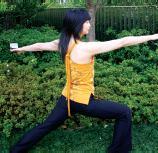Change Point: Survival of the Fittest
Potential opportunities for business in Japan's fitness craze
By Nicole Fall
Consumer trends and fads can be puzzling for marketers. Where do they come from? How long do their last? What risks or opportunities do they present? In identifying social shifts or 'Change Points' this column attempts to zoom in on a particular trend and trace its potential consequences on consumer decision making processes. Using research developed by the Bates Asia advertising agency, as well as a range of media reports, this issue's Change Points are related to Japan's fitness craze.
Background
Expenditure on health-related foods is increasing, dance schools are cropping up throughout Tokyo, yoga is booming and muscular physiques are in vogue. Driving the Change Points behind Japan's newfound fitness craze is a fundamental shift in lifestyles and a focus on natural inner health and appearance. What's the next step? Decades of conspicuous consumption have powered Japan to the top of the luxury-spending league. Yet for some segments of the population buying another branded accessory is not as fulfilling as it once was. As the saying goes, 'Money can't buy you happiness', nor can it for that matter buy good health. But what it can buy is health foods and medical health care services, two of the fastest growing consumer goods and service markets in Japan. Throw into the mix a rapidly aging society - and the investment in a healthy lifestyle becomes a highly lucrative business.
New Japanese Lifestyles
There is always a downside to the good life. Those visits to the gourmet chocolate stores and ubiquitous syrupy coffees with a cake on the side will eventually cause weight gain. While Japan's adult obesity issues are relatively trivial in contrast to the West, childhood obesity is however a growing problem.
There are now government initiatives to tackle this crisis by promoting healthy diets for children after it was found 9% of fourth-graders were diagnosed obese in 2003, up from 5.9% in 1982. Meanwhile 10.8% of seventh-graders were classified as obese, up from 7.3% according to the same education ministry survey. Other local studies have found a direct correlation between larger body mass in childhood and body mass in young adults. Such findings force one to conclude that the Japanese population is slowly but inevitably heading in the same direction as its larger Western counterparts.
The warning bells are chiming. The lethal combination of sedentary lifestyles from children's television available 24- hours a day and the preference of playing video games to physical activities, compounded with a diet of high sugar and high-fat convenience foods will continue to take its toll on the younger generation. The business opportunity lies in finding solutions to this burgeoning problem.
Peak Performance
As larger Japanese body sizes become more common the days of one-size fits all are definitely over, as is the temporary solution of going on a diet.
The Change Point behind this thinking has been the popularity of international celebrities with toned physiques. Sixpacks, muscular arms and bigger yet firmer body shapes from influential role models including Beyonce, Madonna, Hitomi and Shiho have paved the way for muscles on Japanese women to become acceptable. Working out is not only considered cool but essential to building a longer, healthier life.
Aside from the physical outer effects that a run on the treadmill can bring, exercise that calms the mind and brings harmony to stressed-out individuals is also popular. Yoga studios have launched throughout Japan and it has gone from an exercise associated with religious cults to a habitual pastime popular among career women.
For women who prefer coordinated exercise within a group setting, dance schools offering hip hop and music video style dancing classes have proliferated. Studios of all sizes, located mainly in anonymous pencil buildings in Shibuya, offer dance lessons targeting women. The majority of classes are scheduled early evening convenient for after work or school. Since the dance studios are close to Shibuya's popular hip hop nightclubs many women are using newly taught moves from their dance class later on the same evening at a nightclub.
Nike has responded to these needs by producing a line of fashionable dance workout items in technology-driven fabrics that are trendy enough to wear straight from class to nightclub. The sportswear giant has recognized the importance of the fitness segmentation by dividing its women's fitness division into four categories: yoga, running, cardiovascular and dance, while Adidas has also added more fashion to performance active wear in its collaborative range with Stella McCartney.
In June 2005, of 7.9 million women aged 20 to 29, 69.5% were working. This rate exceeds the comparable 67.2% in the US marking the first reversal among women in the same age group. Younger women focusing on careers and the direct correlation of marrying later than previous generations means these women need more 'chill-out' time. From a marketing point of view 
The Change Point behind this is the elevated status of female athletes including Maria Sharapova, who is the world's highest paid female sports star making an estimated JPY2 billion a year and 20-year-old golf pro, Ai Miyazato, who earns around JPY360 million from commercials annually.
These strong role models who earn a living from their athletic prowess are a far cry from the emaciated celebrities famous for being famous. Marketing campaigns from Dove and Nike that capitalize on real women with regular faces and figures are also influencing popular thought. Where to from here?
Potential business ideas include:
- The establishment of children's boot camps or US-style 'Fat Farms' where kids are sent to tone up and lose weight in a safe, outdoor-orientated environment.
- Targeting busy mums-on-the-run with appealingly packaged, brightly coloured o-bento boxes that feature a toy in the centre of the box. The meal would be a healthier alternative to a burger and French fries and be sold at convenience stores.
- Capitalizing on the popularity of matbased activities such as yoga and Pilates and the predilection for hygiene by developing disposable, aromatherapy scented 'Yoga Wipes'. These handy packs could be carried in bags or be available at studios to wipe down mats before use.
- Mobile phone delivered exercise routines: 'personal trainer by mobile'. Mobile gyms' based on the British mobile library concept. Roaming trucks that contain selected gym equipment, operating on a changing daily schedule which drive to remote parts of Japan. This allows penetration of gym brands into towns and villages where there is no market for a permanent presence.
A spoonful of medicine?
In order to survive in what was once a man's world, Japanese women have learned to toughen up. Being financially rewarded for careers and raising the glass ceiling has become equally important as looking good. It is simply no longer enough to be just successful, society dictates women and men also need to look physically beautiful too– and the pressure is on.
The positive physical effects of working out and the mental benefits of yoga practice, taking food supplements and eating organically sourced ingredients are small trends that form a bigger picture. This resonates throughout society encompassing women, men, children and seniors. It also extends to pets and living environment.
Ultimately this Change Point reflects the population's change of focus from outer prosperity to the inner development of personal spiritual health. Working out, taking yoga classes and eating more healthily is just the tip of the iceberg. These are Change Points that affect industries across the board.
For more ideas that can change your business, please contact: nikyfall@gol.com






